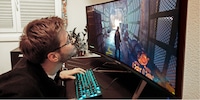

A titan aglow: testing the Philips Momentum 55
The Momentum 55 is a UHD monitor, not a television. According to Philips, it's mainly geared towards console gamers and movie fans. A huge matte VA panel, DisplayHDR 1000, a mini sound bar and Ambiglow are all included to accommodate for this.
The Ambiglow luminosity, directed towards three sides, is impressive. Even before having played or watched a movie on this 55-inch Philips Momentum screen, I was already amazed during a sound check for the mini sound bar with its coloured LEDs turned on. This device «expands» the image behind the device laterally and upwards. I almost forgot that this monitor also has a lot to offer in other respects – a 139.7 cm 4K-120 Hz panel with DisplayHDR-1000 certification, for example.
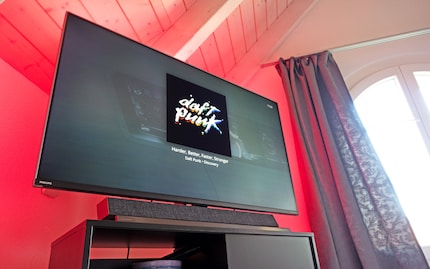
The colourful array of colours behind the TV foreshadows what might follow when playing games or browsing Netflix. I still have no idea if and how the LEDs sparkle, dynamically adapting to the image on-screen. That's a brain teaser for sure. Will I be pleasantly surprised? Or will my eyes start bleeding? Sensory overload?
What this monster monitor is capable of
Why should I buy a monitor with a 55-inch screen when I can just get a TV? Does this thing kill two birds with one stone? Perhaps. After all, the DisplayPort of a monitor is usually superior to HDMI. The Philips Momentum also has HDMI 2.0 installed, limited to 60 hertz at 4K. Only the DisplayPort can transfer UHD content at 120 Hz to the panel.

Technical specs for the Momentum 55:
- A 55-inch UHD-VA-LCD panel with displayHDR 1000, 3840 x 2160 pixels, matte.
- Refresh rate: 120 Hz with DisplayPort, 120 Hz at 2560 x 1440 and 60 Hz at 3840 x 2160 pixels with HDMI.
- Response time (grey to grey): 4 ms.
- Brightness: 750 cd/m², up to 1200 cd/m² with HDR activated (144 backlight zones).
- Contrast ratio: 4000:1.
- Colour depth: 8-bit at 4K/120 Hz, 10-bit at 4K/60 Hz.
- Colour space coverage: 95 % DCI-P3, 125 % sRGB.
- Stability of the viewing angle: 178 ˚.
- Loudspeakers: 2.1 channel speaker (2 x 10 W midrange-tweeter, 1 x 20 W woofer).
- Connections: 1 x DisplayPort (v1.4), 3 x HDMI (v2.0), 4 x USB 3.2 Type-A (two with a permanent power supply), USB Upstream, 3.5-mm jack.
- Additional features: AMD Adaptive Sync Premium Pro, 3-sided Ambiglow illumination, VESA mount (200 x 200 mm), stand can be angled (-5/10 degrees).
- Dimensions (with stand): 1232 x 834 x 308 mm, 26.5 kg (22.7 kg without the stand).
One thing I really appreciate is that the monitor has no smart TV functions. This would just be unnecessary, and I prefer using an external solution like my Nvidia Shield for this .
Connections and use
The Momentum 55 is delivered already mounted on the stand. It can also be angled slightly forwards and back by 5 and 10 degrees. Before I forget, the exclusively digital manual says that I should additionally attach the monitor to a wall behind it with a string or chain for safety reasons. Attaching the device is explained, but I have neither a matching chain nor a wall directly behind the TVscreen.
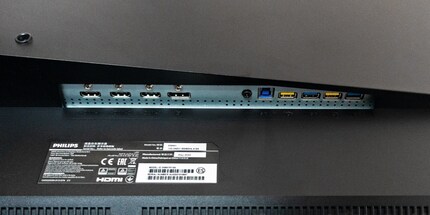
With three HDMI and one DisplayPort, the connections are somewhat unevenly distributed. Either that or Philips believes that consumers, will mostly use HDMI anyway. That may be true, but I'd prefer having another DisplayPort just in case. On the other hand, you get a USB hub with four ports as well as a 3.5-mm jack connector.
The remote control is only equipped with the most important buttons. These are arranged logically and offer everything you need to navigate and change settings. These include the volume control and mute button, brightness control, buttons for navigating and also three buttons with which three OSDs can be called up.
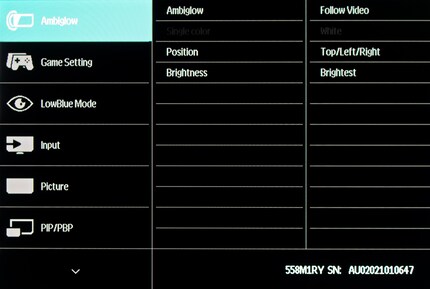
Of course there's also a menu with all the settings you could wish for. Customise Ambiglow, turn gaming options such low-input lag on or off or tweak the colour reproduction.
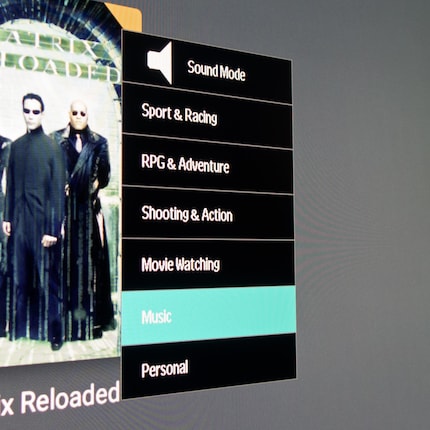
A second OSD, which can be accessed with a single keystroke, offers predefined sound modes.
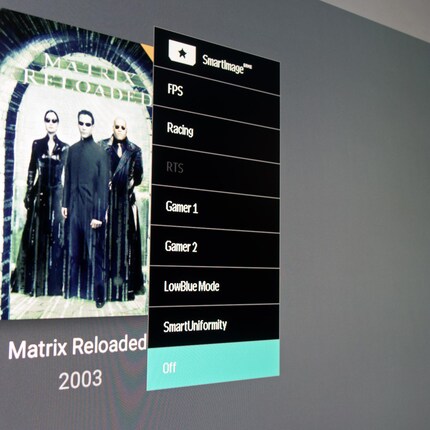
The SmartImage menu contains predefined image modes. The ones shown above appear when HDR is deactivated – the ones shown below pop up when it's on.
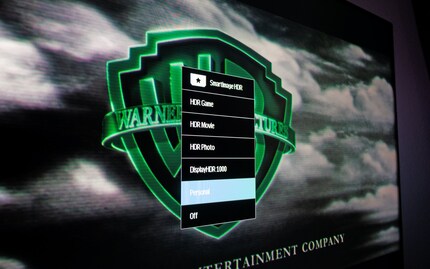
Monitor uniformity and colour space coverage
Before watching movies or playing games, I wanted to know how precisely the built-in VA panel reproduces colours and how the brightness and uniformity of illumination is. According to Philips, the monitor should have a brightness of 750 cd/m². Colour space coverage should be 95 per cent for DCI-P3, and 125 per cent for sRGB.
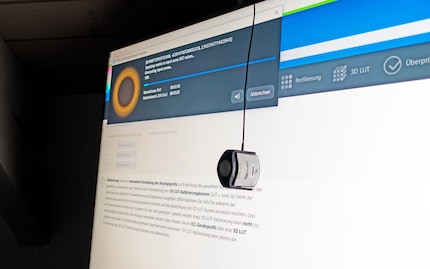
I test whether the model in front of me complies with the manufacturer's specifications using the x-rite i1Display Pro Plus:
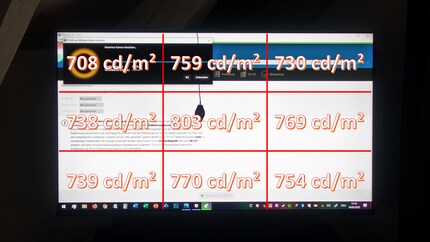
With an average of 752 cd/m², the monitor shines just as beautifully at its brightest level with HDR deactivated as described by Philips. However, the uniformity of illumination isn't quite as ideal. The biggest difference in brightness lies between the centre and the upper left corner and amounts to 95 cd/m². A relatively high value, but other large monitors also struggle with this. My colleague Kevin recently found what he believes to be the ultimate gaming monitor – a Samsung Odyssey G9. Its difference is above 100 cd/m². Large differences like these are hardly noticed with moving pictures – when playing games and watching movies. But when working with Photoshop, something like this can be disturbing.
For colour space coverage I first measured using different settings as a trial run. The monitor also has an sRGB mode, but it wasn't very good and even produced around two per cent worse values than if I let the monitor display the colours natively. I measured 99.8 per cent colour space coverage using sRGB and 91.4 per cent with DCI P3. These are good values, meaning the monitor can reproduce colours relatively accurately. But they don't correspond to what the manufacturer promised. Philips may have misread something in the specifications and indicated the colour space volume instead of the cover. As there I measured 130.7 per cent for sRGB and 92.6 per cent for DCI P3.
The manufacturer didn't note that this monitor also displays Adobe RGB quite well. At about 81.9 per cent. The static contrast is also solid, even a bit higher than stated by Philips for this panel – it's 4317:1.
Sound: how the mini sound bar performs
If you don't yet have an external sound solution, the Bowers & Wilkins Mini Sound Bar will make you happy. It definitely produces better sound than if the speakers were integrated directly into the monitor. Naturally, a «mini bar» offers a larger resonating body.
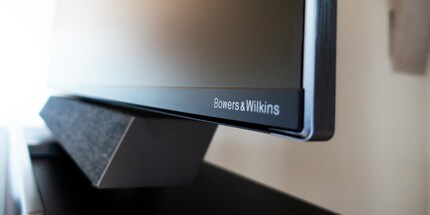
The two 10 and the one 20 watt speakers provide decent sound. Music, films and games were more than enjoyable. The mids, highs and even lows sound balanced and clean. Just as good as a Logitech Z333 in my opinion. If you leave out the subwoofer. But I'm used to other things. In place of test objects, my bedroom usually contains an old second full-HD TV set and a 2.1-Soundbar from Samsung. Those things definitely have more to offer on top of a subwoofer, which I'm really missing here.
Movie playback
I naturally tested with Ambiglow and HDR activated while watching movies. What I immediately noticed when compared to my living room set, a three-and-a-half year old Curved Samsung TV with Quantum Dot technology and HDR10, was the greater depth of the picture. On the one hand, this is made possible thanks to the UHD resolution in combination with DisplayHDR 1000 and 144 backlight zones. Ambiglow definitely also helps.
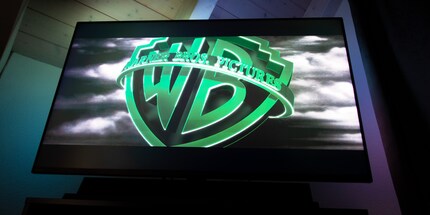
The dynamic background illumination at the sides and above the screen usually adapts very well to film sequences. As far as I can tell, the colours correspond to an average colour value for an image region near the corresponding LEDs. When the screen is dark, the backlight turns off completely. Almost everything fits. Only one thing gets to me at the start; during scene changes, the lighting lags behind for a fraction of a second. But since this lag always takes the same amount of time, I get used to it after only a few minutes. Ambiglow offers an interesting added twist in spite of a mini-delay. It's inspiring and I definitely fell deeper into the events of the film.

I enjoyed the colour reproduction, even if with the monitor is missing the saturation and black values of an OLED model. However, from time to time I recognised a slight backlight bleeding in the lower corners. Far less powerful than what I'm used to from my living room TV. So I don't mind.
By the way, I get the greatest cinema feeling with the SmartImage preset «DisplayHDR 1000». I also have to say that with this device, films can be watched very well even in daylight. Unlike most TVs, it doesn't have a high-gloss coating, which is why annoying reflections hardly ever occur. I like it matt.
Gaming with the Momentum 55
It's a real pity that I can't use the panel's 120 hertz with my PS4 Pro. This remains wishful thinking and a disadvantage of consoles. I prefer this to PC gaming, as I like to lie on my sofa while playing games or in bed.
I remember spending hours in front of CRT monitors. As a result, modern 60 hertz displays are truly magnificent to me. Since the «HDR-Game» Momentum preset has a little too much red, I started my adventure with the SmartImage preset «DisplayHDR 1000» and activated Ambiglow. It displays movies and games accurately.
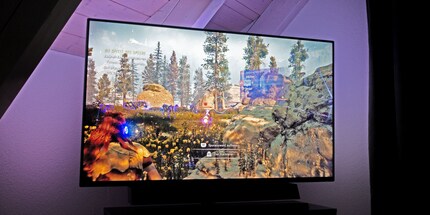
Once again, I feel like I'm watching a film. HDR with lots of backlight zones and activated Ambiglow are a great combination to quickly help you forget about the world around you. I'm really starting to love LEDs now that I think about it.
In order to detect possible shortcomings in reaction time or ghosting, I played Horizon Zero Dawn, The Outer Worlds and Wasteland 3.
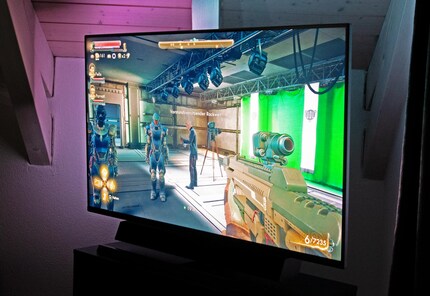
I didn't encounter any visible ghosting artefacts. The VA panel is remarkably solid at handling fast movements. Better than what I'm used to from consoles so far and better than I expected. Most console players should be satisfied with this monstrous display.
My conclusion: a solid VA giant – great LED lighting
Even though VA technology isn't necessarily ideal for gaming, I enjoyed the razor-sharp Momentum 55 UHD panel a lot, even while gaming. Its reaction time is more than sufficient – just like the display: DCI P3 colour space coverage important for films is at 92.6 per cent. DisplayHDR 1000 and 144 built-in backlight zones provide extensive depth and greater space.
But Philips' gargantuan screen is capable of even more. The image in combination with activated Ambiglow provides a true feast for the eyes. Naturally the soft glow behind the screen is secondary. Yet it still triggers something in me. It's... just awesome.
I'm a little annoyed that only one DisplayPort was installed. And that the HDMI connections can only support HDMI 2.0. Könnten die drei Anschlüsse HDMI 2.1, wären sie auch in der Lage, UHD-Material mit 120 Hertz wiederzugeben. By the way, I'm in two minds about the mini sound bar. It does produce decent sound. It's just really missing a subwoofer. It can't even be removed in case you'd want to use your own soundbar with a subwoofer. Still, this isn't a dealbreaker whatsoever.
If you're a fan of LEDs who enjoys movies and console gaming, then Philips might just be able to provide you with long-lasting fun.
I find my muse in everything. When I don’t, I draw inspiration from daydreaming. After all, if you dream, you don’t sleep through life.

